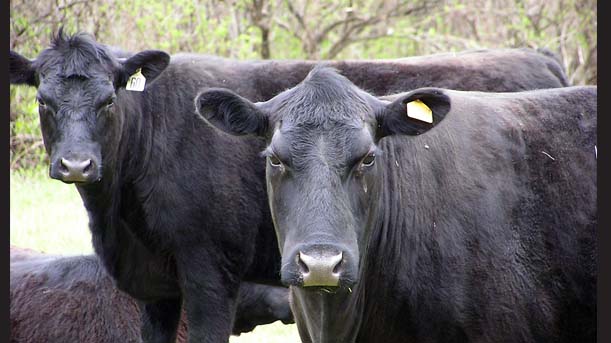Farm & Ranch
AgriLife Extension: Genomic-enhanced data has a place in building back cattle herds

By: Kay Ledbetter
Writer: Kay Ledbetter, 806-677-5608, [email protected]
Contact: Dr. Joe Paschal, 361-265-9203, [email protected]
AMARILLO – Genetic markers are beginning to give cattlemen a more accurate glimpse into their breeding animals’ expected progeny differences or EPDs when selecting for traits to build into their herds.
As the industry begins to rebuild its herds following years of drought, genomic-enhanced EPDs can help cattlemen make more informed decisions, whether they have purebred or crossbred herds, said Dr. Joe Paschal, Texas A&M AgriLife Extension Service livestock specialist at Corpus Christi.
Speaking at the recent Southwest Beef Symposium in Amarillo, Paschal said the Angus and Santa Gertrudis breed associations are already using this tool and he expects others to soon adopt the technology.
Paschal said two things are important when building a crossbreeding program – breed selection and hybrid vigor.
“You need to make selections that fit the market conditions and the environmental conditions you have, because you have to live with those breeds,” he said. “Make sure the right breeds are used for the right reasons.”
Typically, a breeding animal is chosen based on its EPD for a given trait, such as weaning weight. For instance, one bull may have an EPD of 20 for weaning weight and another bull have an EPD of 10, which means the bull with the EPD of 20 will likely sire calves that wean 10 pounds heavier.
EPD traits of interest are birth weight and weaning weight, calving ease score and carcass traits such as marbling, Paschal said. EPDs are calculated from the animal’s data and close relatives and are reported in units of the trait.
“You need to select for all traits that are important to you,” he said. “But traits that are economically relevant, those that have an immediate impact on rate of return, are most important. Selection for economically relevant traits such as weaning weight could increase several pounds or marbling by a large percentage. Selection to decrease birth weight, even by a few pounds, doesn’t affect economics, but selection to increase calving ease does.”
EPDs are not new and are widely accepted in most breeds and have a lot of usefulness in crossbreeding programs, Paschal said.
However, he said, the newer genomic-enhanced EPDs can get breeders a step ahead.
“This process is taking genetic markers and including them into the EPD calculation,” Paschal said. “We can compare known markers in particular young bulls that may not be proven yet and we can improve the accuracy of their EPD values.”
He said less than 5 percent of the people in the cattle business are in the purebred industry, and some of them aren’t going to use it. But with the price becoming more reasonable, $50 for the genomic scans for markers, more could be switching.
“It makes sense to do it if you are in the cattle business because it gives you a leg up on the others,” Paschal said. “You can know something about the performance early in an animal’s life and also know quite a lot about their carcass long before they’re dead.”
-30-
Farm & Ranch
Ag Elsewhere: Wyoming

By Tressa Lawrence
Babies are tucked away in every nook and cranny. Many ranchers across Wyoming have baby animals popping up all over this time of year.
Farm & Ranch
Ag Elsewhere: Montana

By Lindsey Monk
Another load of grain in to keep feeding the calves until the green grass can really start popping.
Farm & Ranch
Meanwhile, Back at the Ranch….

By Rayford Pullen | [email protected]
Spring has sprung and hopefully the rains will continue where our country will heal from the previous droughts and our grasses will thrive. We are especially hopeful for the Panhandle of Texas where our neighbors and friends have been dealt a deadly blow to homes, ranges, livestock, and people. Keep them in your prayers as they will not be able to return to normal for many years if at all. Having lost their ability to benefit from this great cattle market is a double whammy for all of them.
Now is the time of year when we need to take care of business as it relates to our new calves that have been hitting the ground this spring. First and foremost is vaccinating for Blackleg followed by deworming with a white wormer and the IBR complex. Blackleg is a soil-born disease and with pastures extremely short this spring our calves have been grazing the green grass as soon as it shows itself, making them even more vulnerable to picking contaminates from the soil.
To read more, pick up a copy of the April issue of NTFR magazine. To subscribe by mail, call 940-872-5922.
-

 Country Lifestyles1 year ago
Country Lifestyles1 year agoScott & Stacey Schumacher: A Growth Mindset
-

 Equine7 months ago
Equine7 months agoThe Will to Win
-

 Country Lifestyles7 years ago
Country Lifestyles7 years agoStyle Your Profile – What your style cowboy hat says about you and new trends in 2017
-

 Country Lifestyles4 years ago
Country Lifestyles4 years agoAmber Crawford, Breakaway Roper
-

 HOME7 years ago
HOME7 years agoGrazing North Texas – Wilman Lovegrass
-

 Country Lifestyles7 years ago
Country Lifestyles7 years agoDecember 2016 Profile, Rusty Riddle – The Riddle Way
-

 Country Lifestyles8 years ago
Country Lifestyles8 years agoJune 2016 Profile – The man behind the mic: Bob Tallman
-

 Country Lifestyles8 years ago
Country Lifestyles8 years agoCowboy Culture with Clay Reid – Being a Man






